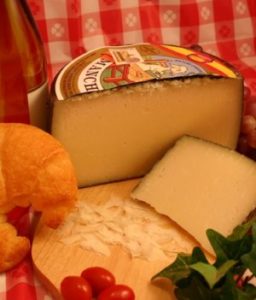Blog
Cheese Glossary: The Letter M
Another letter for our cheese glossary today!

Manchego
Manchego is a sheep’s milk cheese from Spain. The shape of Manchego cheese is very characteristic and defined. It has an intense taste and crumbly texture which makes it perfect for eating alone. It has a rich golden color and small holes. It is traditionally made with grass molds so it has a very distinctive zigzag pattern on the cheese. It appears as a herringbone pattern n the rind, which is inedible.
The rich, semi-firm product is aged in natural caves for two to six months, giving it a zest and exuberant flavor. It is always aged for a minimum of two months. There are significant changes in the flavor over time and sometimes in Spain, you will see it served in a variety of ages.
Manchego cheese is made in the La Mancha region of Spain. It has a long historical and literary tradition, as it was mentioned by Cervantes in the legendary “Don Quixote of La Mancha”.
It is made from the whole milk of the Manchega sheep, which are only bred in the La Mancha region. Archaeological remains show that a cheese like Manchego may have been made as far back as the Bronze Age.
Marbled
Marbled cheese is usually a blend of Monterey Jack and Colby cheese, marbled together to create a striking effect. Monterey Jack is a buttery, semi-firm cheese that originated in California. It is usually only aged for around a month, making it a fresh, fairly soft cheese to enjoy.
Medium-aged
A semi-hard or hard cheese that has usually been aged for three to six months.
Mozzarella
Mozzarella is a semi-soft cheese. Due to its high moisture content, it is traditionally served the day after it is made, but can be kept in brine for up to a week or longer when sold in vacuum-sealed packages.
Derived from the Neapolitan dialect spoken in Campania, mozzarella is the diminutive form of mozza (“cut”) or mozzare (“to cut off”) derived from the method of working. The term is first mentioned in 1570, cited in a cookbook by Bartolomeo Scappi, reading “milk cream, fresh butter, ricotta cheese, fresh Mozzarella, and milk”.
Citric acid and milk are combined and then heated until the mixture is ready to have rennet added. At this point, the curds and whey will have separated and the curds will be cut. They are the removed, stretched and kneaded until they become the cheese that we recognize.
Muenster
Muenster cheese is a mild, white cheese with a reddish-orange rind made from paprika. This can be eaten but is often cut off. It is semi-firm in texture with a mild smell that stronger as it ages. Muenster cheese is currently made in Germany, France, and the United States. It was originally made by Benedictine monks that migrated to the Alsace region of France. The cheese was created to save milk and feed numerous people. The original name “munster” comes from the word monastery. Authentic French Muenster cheese is made from the milk of cows that graze in the Vosges mountains of eastern France. Today, farmers still use traditional methods of cheese-making.
Are you enjoying learning about cheese? Let us know in the comments!




